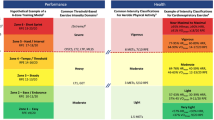Summary
Twelve boys, 7–9 years old, who, by use of questionnaires, were found to be ignorant of the concept of “warm-up”, performed maximal aerobic and anaerobic tasks 4 min after completing a 15 min intermittent warm-up (WU) (30 sec treadmill run, 30 sec pause). The WU required some 60% of the individual's\(\dot V_{O_2 \max } \), and raised rectal temp. by 0.52±0.19° C. The aerobic criterion task (CT) was a one-stage bicycle ride at a load predetermined to exhaust the subject after 4 min. The anaerobic CT was a 30 sec all-out ride against resistance of 35 gm/kg BW. Subjects also performed both CT's without any WU.\(\dot V_{O_2 \max } \) (aerobic CT), HRmax, as well as total mechanical work output achieved during the aerobic CT, were significantly higher with WU, compared with the non-WU sessions. During the anaerobic CT total revolutions, total power output, as well as peak HR, were significantly higher following WU. It is suggested that the benefits of intermittent WU, as used in this study in young children, can be attributed to physiological rather than psychological mechanisms.
Similar content being viewed by others
References
Asmussen, E., Bøje, O.: Body temperature and the capacity for work. Acta physiol. scand.10, 1–22 (1945)
Astrand, I., Åstrand, P. O., Christensen, E. H., Hedman, R.: Intermittent muscular work. Acta physiol. scand.48, 488–493 (1960)
Åstrand, P. O., Saltin, B.: Oxygen uptake during the first minutes of heavy muscular exercise. J. appl. Physiol.16, 971–976 (1961)
Barcroft, J., King, W.: The effect of temperature on the dissociation curve of blood. J. Physiol. (Lond.)39, 375–384 (1909)
Barnard, R. J., Gardner, G. W., Diaco, N. V., MacAlpin, R. N., Kattus, A. A.: Cardiovascular responses to sudden strenuous exercise — heart rate, blood pressure and ECG. J. appl. Physiol.34, 833–837 (1973 a).
Barnard, R. J., MacAlpin, R., Kattus, A. A., Buckberg, D.: Ischemic response to sudden strenuous exercise in healthy men. Circulation48, 936–942 (1973 b)
Buchtal, F., Kaiser, E., Knappies, G.: Elasticity, viscosity and plasticity in the cross striated muscle fibre. Acta physiol. scand.8, 17–37 (1944)
Christensen, E., Hedman, R., Saltin, B.: Intermittent and continuous running. Acta physiol. scand.50, 269–286 (1960)
Franks, B. D.: Physical warm-up. In: Ergogenic aids and muscular performance, pp. 159–191. London—New York: Academic Press 1972
Gutin, B.: Oxygen consumption in the first stages of strenuous work as a function of prior exercise. Columbia Univ., unpublished paper (1971)
Hipple, J.: Warm-up and fatigue in junior high school sprints. Res. Quart.26, 246–257 (1955)
Howard, G., Blyth, C., Thornton, W.: The effects of warm-up on heart rate during exercise. Res. Quart.37, 360–367 (1966)
Inbar, O., Ayalon, A., Bar-Or, O.: A comparison between tasks of anaerobic capacity and other anaerobic tasks (abstract). Israel J. med. Sci.10, 290 (1974)
Margaria, R., di Prampero, P. E., Derevenco, L., Agheno, P., Mariani, M.: Effect of a steady state exercise on maximal anaerobic power in man. J. appl. Physiol.30, 885–890 (1971)
Massey, B. H., Johnson, W. R., Kramer, C. F.: Effect of warm-up exercise on muscular performance during hypnosis to control the psychological variable. Res. Quart.32, 63–71 (1961)
Pacheco, A. B.: Effectiveness of warm-up exercise in junior high school girls. Res. Quart.30, 202–213 (1959)
Pařizková, J.: Total fat and skinfold thickness in children. Metabolism10, 794–807 (1961)
Phillips, H.: Influence of fatiguing warm-up exercise on speed of movement and reaction latency. Res. Quart.34, 370–378 (1963)
Pyke, S. F.: The effect of preliminary activity on maximal motor performance. Res. Quart.39, 1069–1075 (1968)
Richards, D. K.: A two factor theory of the warm-up effect in jumping performance. Res. Quart.39, 668–673 (1967)
Rochelle, R. H., Skubic, V., Michael, E. D.: Performance as affected by incentive and preliminary warm-up. Res. Quart.31, 499–504 (1960)
Smith, B., Bozymowski, M. E.: Effect of attitude toward warm-up on muscular strength and endurance. Res. Quart.36, 79–85 (1965)
Stewart, K., Gutin, B., Lewis, S.: Prior exercise and circulorespiratory endurance. Res. Quart.4, 169–177 (1973)
Author information
Authors and Affiliations
Additional information
Supported by a grant from the Sport and Physical Education Authority, Ministry of Education and Culture, Israel.
Rights and permissions
About this article
Cite this article
Inbar, O., Bar-Or, O. The effects of intermittent warm-up on 7–9 year-old boys. Europ. J. Appl. Physiol. 34, 81–89 (1975). https://doi.org/10.1007/BF00999919
Received:
Issue Date:
DOI: https://doi.org/10.1007/BF00999919




